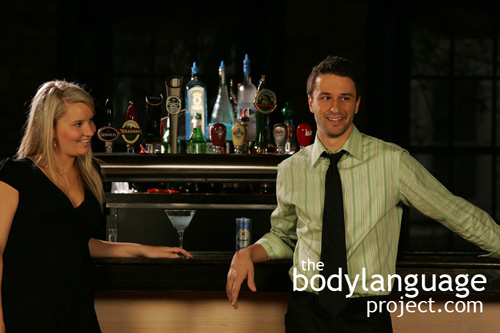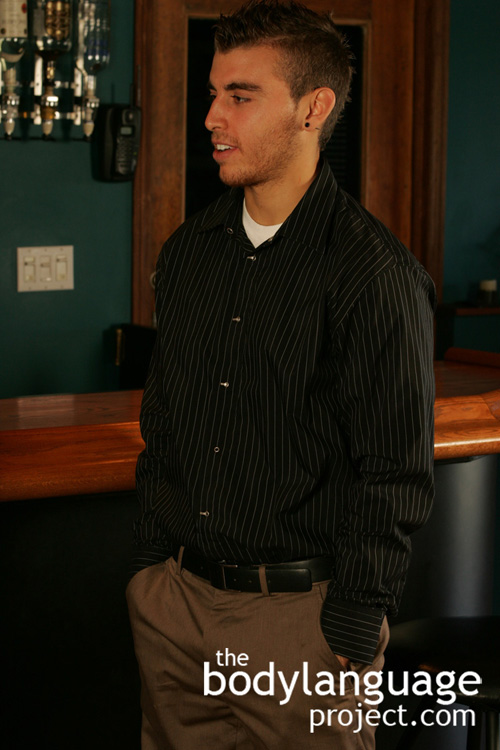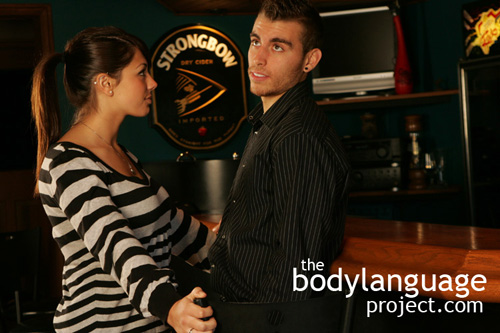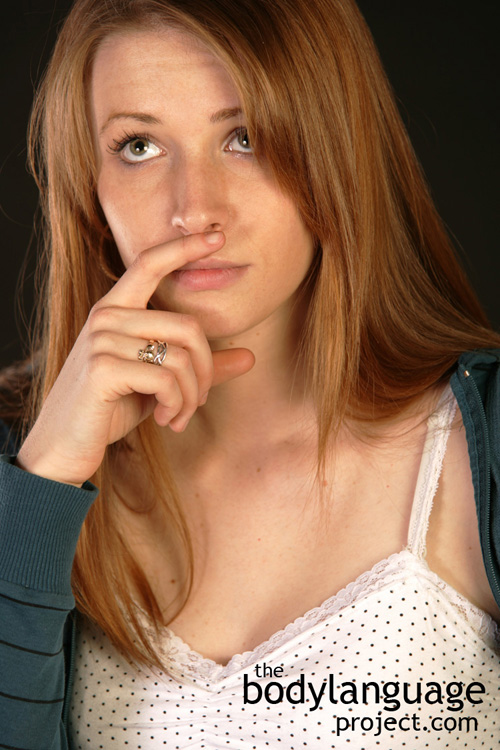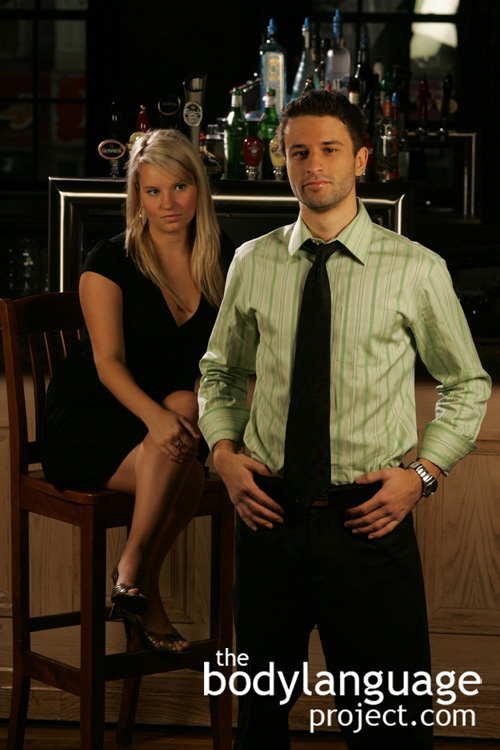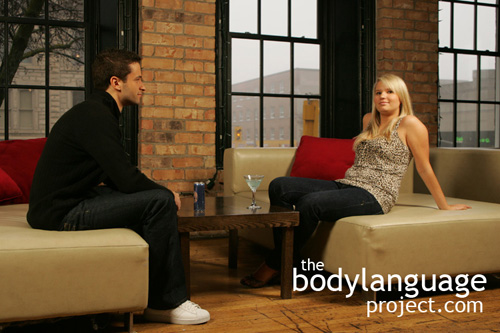Since openness is a reaction to comfort and being closed relates to fear of attack, it is natural that we should see more dominant people hold more open postures and subordinate people hold more closed postures. An employer, for example, being more comfortable in the workplace would be expected to hold his hands to his sides, rather than have his arms crossed, use a palm down handshake showing dominance and generally avoid holding himself up against objects or hidden behind objects like coffee mugs or folders. His subordinate employees, on the other hand, would feel more comfortable with their hands in their pockets, finding refuge against the back of a chair, leaning against a desk, or hiding behind a notebook. Employees might also take up an arm cross, either in full, but usually only in part, by grab their opposite arm or elbow, and tuck one leg behind the other in the ankle cross. Employees will avoid a full arm cross because they don’t want to appear totally closed to the suggestions of their employer.
Tag Archive for Openness
Being Opened And Closed Through The Legs And Arms
by Chris Site Author • March 5, 2013 • 3 Comments
Throughout this chapter being “open”, refers to a frame of mind that is willing to accept information, to hear others out and to consider taking action whereas a closed mind, or being closed indicates the opposite. As mentioned previously, having an open and receptive mind is indicated in body language through the absence of closed postures.
It has been shown that frowning requires more muscles and effort than does smiling and so naturally our default facial expression is the smile. Similarly, openness as it relates to body language is the default mode because a relaxed body requires less effort than one that is tensed or closed. To take a negative posture, we must actively close our bodies off requiring effort and to exercise effort we need motivation. In this case, motivation can come from any fearful or unwanted stimulus that precedes a fight or flight response. That is to say that, closed body language are the postures we while see as a negative decision is being analyzed and so is a predictor of a bad outcome.
Being completely open allows us take our most comfortable position, such as what we might do on a couch or in bed in our own house. We might lay our arms out and take up space, put our hands above our heads, spread our legs open or even lay down completely. Having open body postures is akin to being totally exposed to the word and all the harmful things in it, but possessing no fear of harm. Of course, we permit ourselves to hold open postures precisely because we expect nothing harmful to happen. In other words, our bodies are permitted to relax when we are open and contract and tighten when we are closed.
Thus, it takes muscular effort to close the body off whereas open postures occur without action at all. When viewing open body language imagine the extremity of the postures, which as mentioned, can be likened to being on a couch at home. An even more dramatic example is to view open body language as that language exhibited by someone who is intoxicated. Their language is loose, their arms sway freely, they stagger, they have no worries about being ridiculed or attacked and they don’t cross their arms or legs. The cerebral cortex of the drunk, the part of the brain that helps in judgment, amongst other brain centers, is disrupted producing depressed inhibition, increases talkativeness and makes people feel more confident. Alcohol also increases pain thresholds, numbs pain, and makes people feel sluggish because it suppresses the brains ability to function. So for our purpose, the drunk makes a nice example of open body language since he lacks fear, but even if he did, he’d still lack the coordination and strength to carry out a defensive posture.
As a rule of thumb, closed body language happens whenever one of our limbs crosses the mid-point of our bodies. Such is the case during leg and arm crossing. Open postures, on the other hand, happen when the legs and arms remain un-crossed leaving the torso and groin exposed. Of course there are various ways in which the legs and arms can be crossed and these all mean different things which we cover next.
Hands And Palms Language
by Chris Site Author • March 5, 2013 • 0 Comments
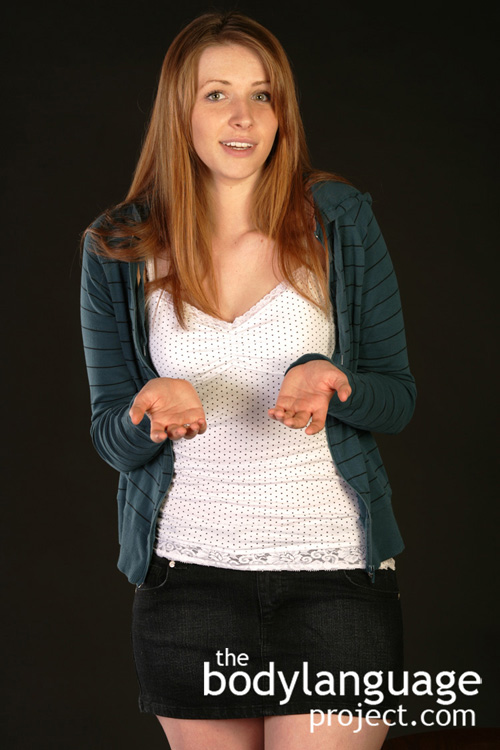
The “offerer” in the rogatory posture wants to give you his thoughts and just doesn’t understand your point of view.
The human brain has been shown to place a disproportionate amount of attention on the wrists, palms, fingers and hands compared to the rest of the body. Throughout evolution as we developed the ability to walk upright, our brains became fixated on what our hands were doing because they became more expressive in language through gesticulation, became more skilled such as creating fires, catching prey, collecting berries and building structures and tools to do so. However, our where our hands differ significantly from our feet is their ability to become extremely dangerous. Hands coupled with weapons can inflict deadly blows.
Being open means being honest and not hiding anything. In evolutionary terms, the palm display is an important gesture signifying honesty because it is a way to make evident to others that no threat or weapon is present. Palm and wrist displays have even been noted to be sexual in nature and more frequently flashed by women during courtship likely because it is such a vulnerable part of the body. The wave, as a long distance greeting, probably has roots in showing that we aren’t carrying a spear, sword, or bow and arrow. Having the hands deep in a pocket or behind the back can be a sign of aggression or passive threat, and our evolutionary history tells us that someone who is hiding something is probably not hiding a bouquet of flowers. But if they are, why take the risk! Showing open palms, facing up, or the “palm flash” is essentially what would have happened thousands of years ago when two foreign tribes met. Even today we might guess that a stranger approaching us on the street was up to no good if they hid their hands at their backs or tucked inside a jacket. We’d think they were harboring a gun and planned to rob us.
Having the arms out and extended, palms up, or vertical shows that we are safe and therein lies our most popular greeting, the handshake. The degree to which this openness occurs represents the degree of openness. Having the arms completely to the side or up and open with fingers apart is as open as one can get and it signal as much. We rarely see this form of openness, rather, openness is of degree, so we therefore must look for more subtle and acceptable cues.
Open gestures are accompanied by phrases such as “Trust me.”, “I wouldn’t lie to you.” and “What, you don’t believe me?” We also gesture with palms facing upward when we are offering something. However, the offering, in this context, isn’t a tangible item, rather, it’s an idea. It could be a cell phone plan coming from a salesman in the mall, or a reorganizing of the company, a downsizing, or new way to deal with customers or any number of things requiring deal making or selling.
When the arms are completely outstretched with palms up we call it the “rogatory” posture, or prayer-like. It is as if we are offering dialogue to another and sincerely want to be believed, trusted and accepted. This posture is not dominant or even confident however, because it lacks conviction. So while palm flashes show honesty and trustworthiness because they show no threat, they lack sustenance and power in terms of conviction. Palm down displays though, by placing hands face down on a table or standing head on and leaning with the fingertips spread to anchor the body shows emphatically that a position is held confidently. While conversing on a topic, we should therefore expect both palms up and palms down as opinions are either offered with reservation or presented with conviction. Depending on your position on the matter you may wish to employ either submission or dominance to your advantage. For example, on issues you wish to concede or are unsure of, of which making the other party aware of this fact is acceptable, use palm up, but when you wish not to concede or wish not to be uncovered as unsure, keep palms face down. The rule of thumb is that palms down “tell”, while palms up, “offer.” When someone wishes to display honesty, such as declaring “You have to believe me, I didn’t do it” they should use palm down displays otherwise they may not be telling the truth and expect not to be believed.
So why do we find it comfortable to put our hands in our pockets? Our clothing, especially that of men’s, is specifically designed with this in mind. The fashion of women rarely permits the luxury of the same deep pockets, but this isn’t to say they wouldn’t take advantage of them if they could. Curiousity says that we must reason why this is so. What is it about this hand placement that makes us more at ease? Are men more reserved to the point of requiring their garments to accommodate their needs or is it just superfluous? There’s no doubt that form meets function in this case, and putting our hands in our pockets makes us feel more comfortable and gives us a way to occupy our hands, but what does the body language convey to others?
When children lie they can be found to place their hands behind their back concealing them. This is a dishonest gesture. As we grow into adulthood, this gesture becomes more condensed and our hands find a new place in pockets. Seeming outright dishonest for having your hands buried in pockets is a bit extreme, but context specific could be a ‘tell.’ Regardless though, hidden hands convey a lack of confidence especially when the hands would be best served to gesture appropriately in conversation. The hands are a very effective way to colour our dialogue and make us appear more honest and intelligent. When delivering important information showing the flesh of the palms, the “palm flash” can be critical to portray honesty. At a subconscious level, as the palms are made more visible, the more honest others will find the speaker. Give it a try!
Introduction – Chapter 7
by Chris Site Author • March 5, 2013 • 0 Comments
Openness can sometimes be confused with simply being relaxed or intense, and to some degree this is true. For example, being open often means that attire is also relaxed, shirt collars are unbuttoned, ties removed, the pants might hang loose and certain articles like jackets might be removed. Full openness, therefore, is not always acceptable. Conversely, we might look at being open as simply a lack of holding closed cues. That is, having open cues is the exact same as not displaying closed cues and is the default position of the two. Being closed requires a certain amount of tensing of muscles and therefore effort so the default of most people is having an open mind. In other words, people are open, unless they say otherwise! It follows that there are far fewer cues to symbolize openness as opposed to closed, since being open is more of a passive state.
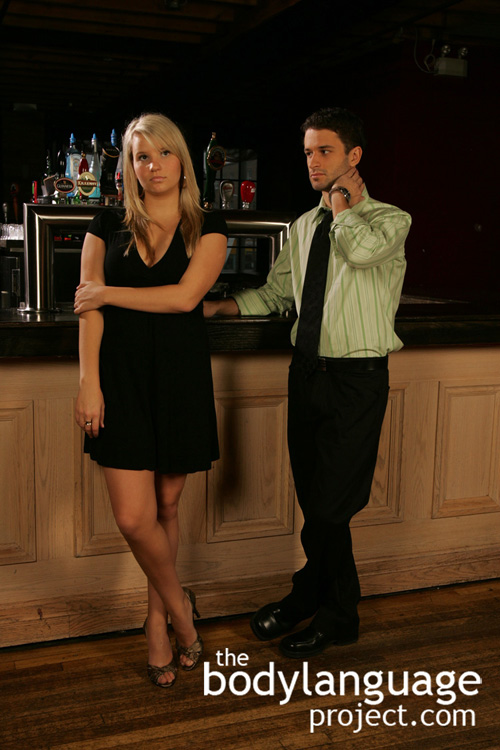
Closed body language happens whenever a part of our body crosses the center-line. Arms are shields that protect our torso from harm.
When closed postures are combined with other closed postures, the signal intended is made more obvious. For example, leg crossing in combination with arm crossing is much more potent than either alone. Add to this an expressionless face, turning away, and one is left to assume that communication is not welcomed at any level. On the other hand, we might be faced with someone who has their legs crossed but the arms are opened and honest. In this case, we might assume that it is a deliberate and conscious attempt to appear relaxed, when in fact the person might not be relaxed at all. It might be the case too, that someone has mixed feelings and is reserved at one level, but open at another level. Reading opened and closed body language is tricky business, but all cues are additive. Cues of the same origin, happening together, serve to strengthen an open or closed reading, but so too does conflicting cues. Conflicting cues tell us that someone has an internal reservation, made obvious through their mixed message.
It is fortunate for those of us who wish to modify our body language, that we have control of our conscious mind, since we then can modify our body language as desired.
Of course, since de-linking of our bodies and minds is difficult, these changes bring about inherent change in our attitudes as well. For example, it’s fairly easy to consciously carry open postures, such as palms up, arms and legs uncrossed, and hold active eye contact, however holding these postures necessarily leeches back into us creating open feelings.
In this chapter we will examine the vast array of open and closed body positions that we can use to come across as more or less open, as we desire. Naturally too, we will be able to identify this same body language in other people and use it to our advantage when reading them.
Gazing
by Chris Site Author • March 5, 2013 • 0 Comments
Eye contact and gaze are some of the most salient nonverbal behaviours in human interaction. It is the first connection a mother has with her infant and the first interaction that infant has with anyone. Through gazing forms a very powerful and special bond between mother and infant. However, even mothers differ in their strength and frequency of gaze with their children. Affectionate mothers will go out of their way to kneel so as to bring their eyes into level, whereas, less affectionate mothers tend to lean forward instead and use gaze much less frequently. These experiences from early development formulate our norms which can persist throughout our lives. Only with conscious effort can we change them, but first we must understand the purpose and function of gaze and also what good gaze habits really are.
Over the course of a typical day, eye gaze can reveal cues to interest, attention, affiliation, intimacy, approval, dominance, aggression and openness to personal involvement. Gaze happens in a much different way than a stare. Stares are like daggers, shooting invisible arrows into the face of another. A gaze is inviting and a display of warmth. A gaze includes the attachment of a positive emotion which men sometimes have difficulty with. Lovers are particularly adept at gazing, with bouts sometimes lasting for several minutes, other times even much longer. As early as six children seem to pick up that eye contact and gaze indicate a connection. Young girls tend to realize it sooner than young boys and women tend to enjoy gaze more than men and so use eye contact and gaze more readily. Additionally, women will hold eye-gaze for longer periods of time than men, which is most evident when women gaze at other women.
Gazing is eye language that can take up various meaning depending on how it is done. The “face-gaze” happens when one person directs their eyes at another person’s face. “Eye-gaze”, on the other hand, happens when the gaze is directed toward the eyes of another but of which that person might not reciprocate. “Mutual-gaze” happens when two people look each other’s faces which might include bouts of eye-gaze and “eye-contact” refers to two people looking directly into each other’s eyes. Other forms of gaze include “omission”, defined as a failure to look at someone without intending to and “avoidance”, in which a person purposely prevents eye contact. Most are familiar with “staring”, but to be sure, we define it as a persistent look that occurs regardless of what another person is doing. Simply defining the types of gazes and eye contact likely evoke some pretty strong feelings which can be positive as in the case of mutual gaze or negative as in the stare. Prolonged eye contact early in a loosely established relationship is almost always taken negatively, or with hostility, and decoded by others as offensive. We may even think prolonged eye contact is a result of projected dislike or even disapproval of others, even when it is the result of affection or attraction. Holding gaze for as little as three seconds longer than normal can come across as over-assertiveness and create contempt. However, because we aren’t always aware of eye contact consciously, others won’t be able to describe the reason for their feelings which is why the use of gaze needs to be taken seriously.
Recognizing Body Affect By Culture
by Chris Site Author • March 5, 2013 • 0 Comments
In 1969 researchers Albert Mehrabian and John Friar found that a person’s state, their mood, and their emotional state were reflected by changes in body positions. In this context we are referring to affect in terms of simple gestures like leg crossing and arm crossing to indicate a closed mind or palms up and arms uncrossed to show openness or a willingness to listen. In fact, most of this book covers body affect and systematically breaks it down in future chapters. This cultural discussion is therefore important in that it describes the universality of body language.
While little research has focused specifically on measuring emotion from body positions, it has been found that the central nervous system is responsible for perception of emotion and this emotion is fed back into our body’s machinery to produce affect. The ways in which people convey emotion through body positions (or affect) is mediated by many factors including age, gender and context. Despite these factors though, body positions due to emotion, also has a cultural component. It is generally agreed that the face holds particularly universal expressions in terms of emotions as mentioned in the previous section, but the remaining language spoken by the body seems less obvious.
For example, the Japanese tend to be less expressive with their body language overall and therefore rate others more intensely on their nonverbal language. In a 2006 study by Andrea Kleinsmith and her colleagues out of London it was found that even mild expressions were rated as more emotional by the Japanese subjects over the ratings of other cultures on the same affect. A Westerner in the eye of the Japanese appears like a flailing uncontrolled windmill with their arms moving about as they gesticulate while they speak, whereas the Japanese appear rigid and uptight to a Westerner. In the study however, the meaning behind body language was still rated similarly across all cultures showing that emotion does have universal traits and crosses cultures. Thus, while the amount of affect does vary across cultures, the meaning behind the body language crosses boarders.
Context
by Chris Site Author • March 5, 2013 • 1 Comment
Context is another important factor to consider while reading people. We often hear about verbal statements that are taken out of context and in this same way, we can take nonverbal language out of context as well. “That guy was obviously lying, he was scratching his face and neck and could barely sit still” might be accurate when being grilled by a panel of the media over missing fund money, but in the context of being attacked by a swarm of killer bees, not accurate at all!
Concluding that someone is cold hearted from a single meeting is another case of ignoring context. We often think people are shy after a first meeting, but are surprised that over time they open up and are actually quite expressive and talkative. However, what we fail to realized at the time might be that during an initial meeting, our subject of interest hadn’t been acquainted with any of the other twenty people in the group and as a natural consequence we acting as any normal person would. Temperature can also play havoc on cues of openness. Someone who crosses their arms tightly and crunches up could be defined as closed or aloof, but they also might be cold. Conversely, removing a jacket could mean that a person is warming up to others but could also mean that they are overheating.
Single events taken as all encompassing can set us up for problems in the future. A brief meeting in one location, with one set of people, centered on one task can not define any person. Single meetings only show how a person reacts on that day, based on whatever happened before then to set their mood and with whomever happens to be there. People are very complex, and so we must give them plenty of opportunity to display their true selves before drawing solid conclusions. This does not mean that what we gather on each occasion is useless, but rather that it needs to be compared across many situations before it can be used accurately. Until similar patterns develop across many different situations, take isolated incidents for what they really are. Predictive power happens through repeating patterns across many events and in many contexts.
Why We Should Picture People Naked!
by Chris Site Author • March 5, 2013 • 0 Comments
My final thought in this opening chapter should keep your imagination in full gear because I am about to recommend that you do something naughty to become more proficient at reading body language. I’m instructing you to picture your body language subjects as if they were totally nude! Body language cues came about over our evolutionary history, so it naturally follows that they developed without clothing or coverings. Imagine, for example, a full body steeple where the arms are placed behind the head and the body leans back with the legs spread wide open – a crotch display! It is the way a proud (or arrogant) man sits to put his full package on display. True, it is slightly less offensive with clothing on, but it still carries the exact same meaning since its true intentions were delivered as if the clothing were absent. Picturing people naked helps us to think about not just the message, but also the route behind the message. Men who hold their legs spread wide open are perceived as arrogant but women who hold the exact same posture will be thought of as sexually open or “easy.” While each party might not specifically intend to deliver this message, it matters little to how others subconsciously perceive them.
Arrogance and sexual openness are not the only gestures that are made more salient by picturing people naked but they are the most dramatic. We can also picture meek gestures in the same way. Women that place their hands over their laps are doing so for just the opposite reason as do women who spread their legs, they do so to hide or protect their genitals for view or from access. The same intention is obvious when women fold their arms over their chest. They are trying to hide and protect their breasts since someone or something has made them withdraw and has made them insecure. Naturally, their arms fold, one over the other, and they hide from view something important to them. There will be times though, when protection isn’t the reason, arm crossing due to being cold is one of them. We will discuss the importance of context in this regard in more detail later. There are other times still, when women put themselves on full display. Women do so by walking with their hips forward and chest back. This is called the parade and her intension is to have men and subordinate women take notice. If you have trouble visualizing this, put it in the context of the local nightclub. Suddenly you see that it follows naturally, and next time at a bar, you might actually notice it in an authentic context.
While we are on the subject of nudity, think about how and where we hold our possessions. A handbag can be held to our sides, but equally, it can be placed on our laps or held to our chest. Handbags therefore, can have a protective shielding purpose, as do other objects in our environment and some women will even admit this as fact by tell you that they feel naked without one! Desks can be used as barricades to block ourselves from view and chairs with backs can be used in full on assault by turning them backwards and straddling them, putting the “boys” or “girls”, on full display. Then from the security of our seated position we can toss verbal arrows and spears. People who sit in this way are obviously aware of being fully clothed and most certainly wouldn’t sit this way while naked, but that’s not the point. The point is that people continue to sit this way despite holding the evolutionary hardwiring telling them that the way they are sitting is offensive. Someone that is defensive, on the other hand, will use desks, walls, doors, or other barriers to protect and hide themselves rather than flaunt. You can think of shields such as handbags or jackets like towels, objects that we use fresh out of the shower to block our private areas from view and appropriately conceal our modesty. An excellent example of a real life “towel” and one that is very commonly used during presentations is the podium. Most would say that it is a great place to store our notes and an area to place the microphone, and nothing more, but in reality it’s a place of refuge that public speakers us to escape full view of the crowd. Only the most confident speakers who are accustomed to being exposed in front of large audiences will move about a stage for everyone to see.
So in summary, do as any amateur public speaker is recommended to do, when in doubt, and to make the points expressed in this book more salient, picture your targets naked!



